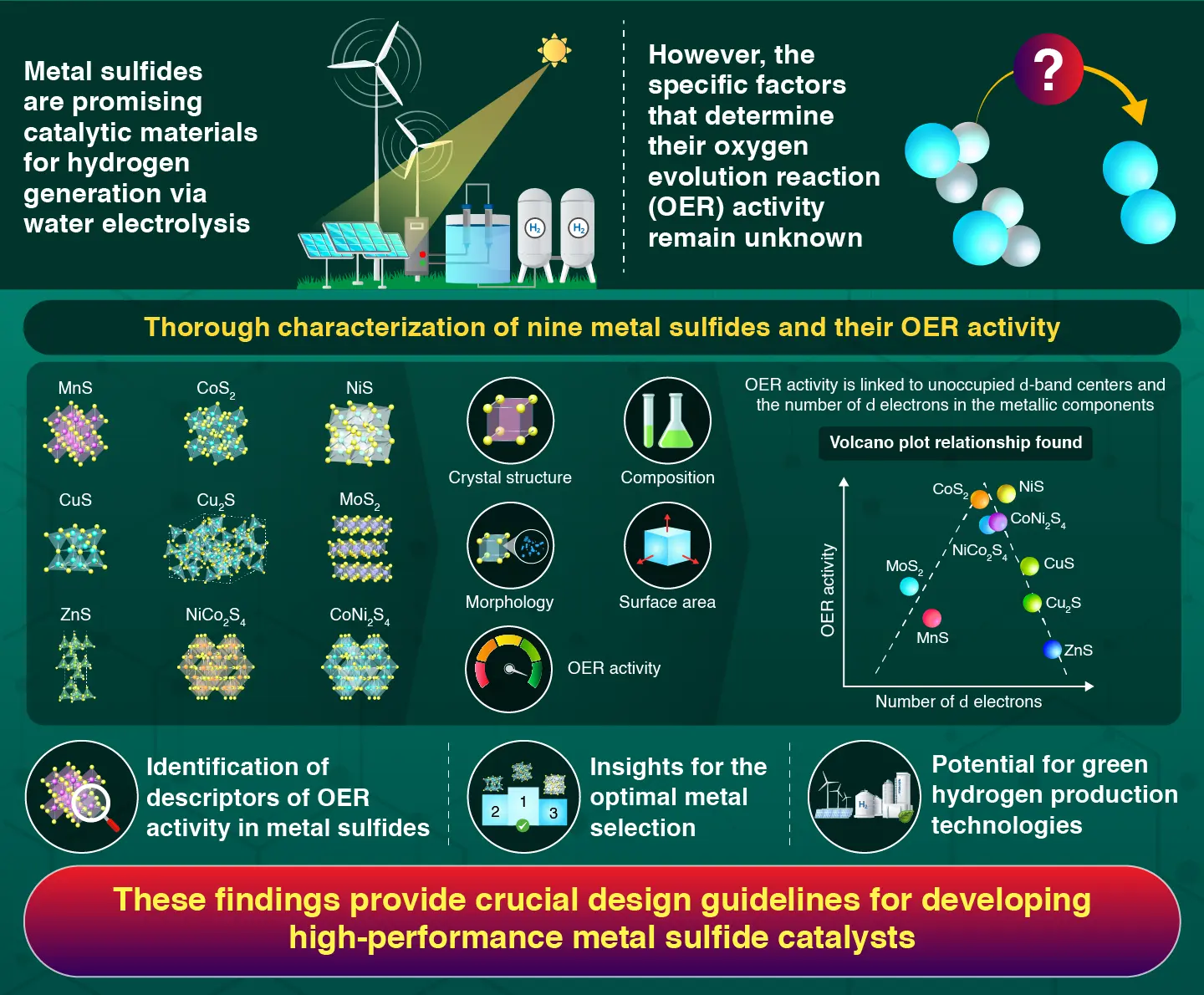Metal sulfides with seven to eight d electrons show optimal performance as catalysts for water electrolysis, as reported by researchers from Institute of Science Tokyo. In a comprehensive analysis of various metal sulfides, they identified a volcano-shaped relationship between catalytic activity and the number of d electrons in metal atoms. This newly uncovered principle will form the basis of catalyst design guidelines, accelerating the development of efficient water-splitting catalysts for green hydrogen production
Analyzing the Performance of Metal Sulfides for Water Electrolysis

Sugawara et al. (2025) | Catalysis Science & Technology
The global energy crisis and the urgent need to combat climate change have made the development of green hydrogen a top priority. As a fuel that boasts exceptional energy density and produces only water when used, hydrogen is a highly attractive alternative for fossil fuels. Moreover, hydrogen can be obtained by splitting water molecules through a process known as water electrolysis, which in turn can be driven by electricity derived from renewable sources. However, a significant hurdle remains: the oxygen evolution reaction (OER), which occurs at the anode in the presence of precious metal-based catalysts during water electrolysis, still represents a major bottleneck.
In the ongoing quest for better OER catalysts, metal sulfides have emerged as highly promising materials. They offer unique electrochemical properties, including stronger covalent bonding and superior electrical conductivity, compared to traditional metal oxide catalysts. Despite their potential, engineers still lack fundamental design principles to predict which metal sulfides would perform best as OER catalysts and why. This has made developing efficient metal sulfide catalysts a trial-and-error process, hindering progress in the field
Against this backdrop, a research team led by Professor Takeo Yamaguchi from the Institute of Integrated Research at Institute of Science Tokyo, Japan, has made a remarkable discovery that could accelerate metal sulfide catalyst development. Their study, published in the journal Catalysis Science & Technology issued by the Royal Society of Chemistry, investigated nine different metal sulfides to uncover the principles governing their catalytic performance
The researchers synthesized metal sulfides containing various metals, including manganese, cobalt, nickel, copper, molybdenum, and zinc, and tested their ability to catalyze the OER. They combined experimental electrochemical measurements with advanced computational analysis to understand why certain materials performed better than others. "We aimed to establish a comprehensive descriptor for the OER electrocatalytic activity of metal sulfides by conducting a systematic investigation to elucidate the main factors influencing the OER," explains Yamaguchi.
The team's analysis revealed two key factors. First, they found that metal sulfides with lower-energy unoccupied d-orbital centers in their metal atoms showed superior catalytic activity—a relationship similar to what had been observed in metal oxides but never before demonstrated for sulfides. More remarkably, they discovered that catalytic activity forms a volcano-shaped graph when plotted against the number of d electrons in the metal atoms, peaking between seven and eight d electrons. This volcano plot relationship occurs because metals with fewer d electrons bind reaction intermediates too strongly, while those with too many bind them too weakly. Thus, optimal performance appears to require a balanced interaction. "For the first time in the world, we have discovered a previously unknown principle—that the activity of metal sulfides is determined by the number of d electrons in the metal," highlights Yamaguchi.
Taken together, these findings provide researchers with concrete guidelines for designing more effective catalysts. By using d electrons as performance descriptors in metal sulfide candidates, scientists can now predict which combinations are most likely to function as high-performance OER catalysts, thereby reducing development time and costs.
As countries worldwide invest heavily in hydrogen infrastructure, this fundamental breakthrough offers a clear path toward the efficient catalyst materials needed to realize a sustainable hydrogen economy. Hopefully, water splitting will become our go-to method of producing clean hydrogen in the near future.
Reference
- Authors:
- Yuuki Sugawara1, Taisei Uchiyama1, Maxim Shishkin1, and Takeo Yamaguchi1*
- Title:
- Electrochemical Oxygen Evolution Catalysis of Metal Sulfides: A Systematic Study of Electronic Effects
- Journal:
- Catalysis Science & Technology
- DOI:
- 10.1039/d5cy00200a
- Affiliations:
- 1Laboratory for Chemistry and Life Science, Institute of Integrated Research, Institute of Science Tokyo, Japan






